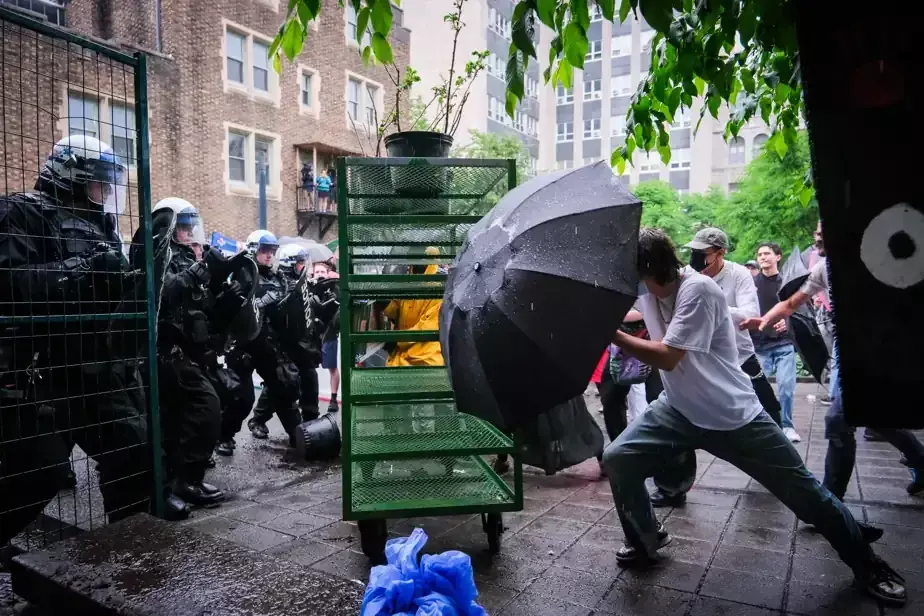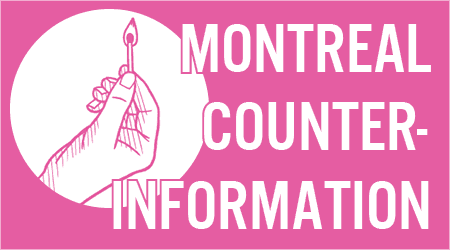
Anonymous submission to MTL Counter-info
June 6, 2024 will live long in our memories.
What happened that day was more than impressive. A riot emerged spontaneously on the McGill campus in response to police violence and a convergence of forces from the student intifada.
Since the media coverage seems to gloss over the strength of youth resistance that day, it seems important to take a look back at the day’s events.
First of all, a demonstration had already been called by the forces of the Université Populaire Al-Aqsa (UQAM), which ended its occupation earlier in the day. Parallel to this, an occupation of the Mcgill administration building was organized by students from the university. It was around this occupation that the riot was organized.
Following a call for support from McGill groups, a hundred or more activists converged on McGill to support the students barricaded inside the building.
The police on the ground acted with excessive aggression in the face of the fairly strong passivity of those present. Physically forcing the students who were blocking the secondary doors towards the main gathering in front of the front door. Hundreds of police officers were then mobilized to secure the area around the building and allow the police officers inside to intervene and arrest the 13 students trapped inside.
The aggressiveness of the police and their ridiculous effort to arrest a handful of students quickly heated things up. The students on the ground began to prepare for a police dispersal operation. While a small line held the west of the area, the forces converged to the east to hold a line against the massing riot police. Aided by more experienced activists, the students then began to stand in collective defense formations. Shortly afterwards, the police attempted a first charge into the lines. Surprisingly, despite pepper spray, gas, shields and truncheons, the lines held firm. While the bulk of the force seemed to be made up of activists new to street confrontations, the lines withstood a police charge and managed to push back the riot line. Perhaps the escalation of violence that the police have been building up since April 15 has succeeded in completing the movement’s efforts at self-pacification. Whatever prompted the people gathered there to stand firm, their actions were more than commendable.
Some of those present then retreated in the face of the irritants, but many of them returned to reinforce the lines. Lines that held off a second charge (notably using fencing, ramps and other obstacles) before a third charge finally broke through the line of students. The ego-stricken police then proceeded to brutalize as many activists as they could. Instead of demobilizing the group, this violence reinforced the militant rage. They gathered in the middle of the campus.
While these clashes were taking place, UPA forces arrived in support. Taking up positions on the other side of the police force, they threatened to entangle the police with the demonstration in support of the south. The students tried to resist, but were eventually forced to retreat to the south entrance of the campus.
The forces of both groups then regrouped on the edge of Sherbrooke and, under the call of the radical forces within the demonstration, took to the streets.
Motivated to go and get their arrested comrades, enraged by the violence they had suffered and motivated by the strength of their resistance, the students then engaged in a harassment of the police line laid out around the administration building. Although the forces of resistance failed to de-arrest the comrades, they forced the police to withdraw to their position.
As night fell and tension began to mount again, the students abandoned the campus and took to the surrounding streets. The forces of the student intifada learned the language of the riot, bank windows were smashed, police officers were fired upon with pyrotechnics and rocks rained on them, and every available object to form barricades was used to block access to police vehicles as the students took control of the streets for a few hours.
We must learn from this day and ensure that the movement never goes backwards. The intifada must realize its full potential.
A first lesson is to abandon the black bloc in this kind of demonstration. By dispersing into the crowd, experienced revolutionaries were able to blend in and pass on to the people there the practices of resistance to the police. Let’s adopt the movement’s uniform: the kefffiyeh bloc is in with the times.
A second lesson is to address the crowd clearly in demonstrations, ignoring peace police of all kinds. While self-proclaimed leaders, seemingly detached from student groups, were trying to disperse and pacify the crowd, our more experienced comrades and students were out in the field explaining to people how to resist and encouraging them to hold their ground against the cops. Less experienced militants expect those who know how to resist to guide them in action. We can’t continue to act as a force separate from the rest of the demonstration, we need to see in the faces present in the demonstration as many comrades. We must counter the leadership of opportunists, pacifists and other saboteurs.
The final lesson is to seize the opportunity to escalate when it presents itself. When the police make mistakes, when they brutalize and reveal their face, revolutionaries must be among those left to hold the lines and encourage young people to follow us. We also need to put the police on the defensive, attacking them and forcing them to defend specific targets, so as to have free rein in the streets.


